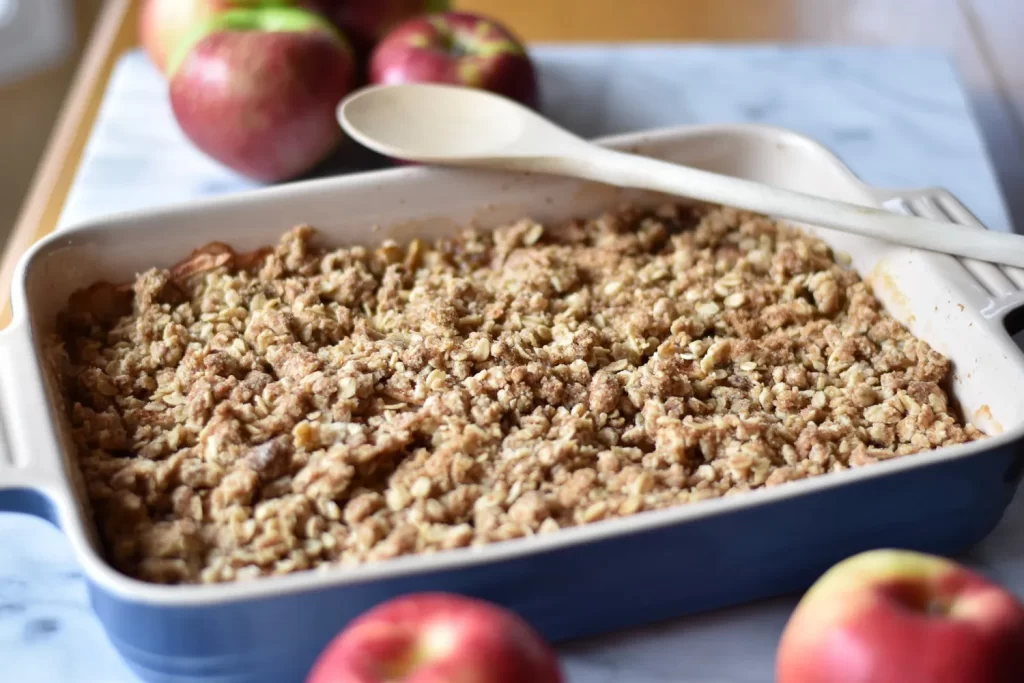This post may contain affiliate links. If you click on an affiliate link and buy something, I get a percentage of the sale. Find out more by reading my affiliate policy and disclosure.
Not all fruit is created equally when it comes to fibre. If you’ve ever wondered what fruit has the most fibre, I am here to help.
The TL;DR version: raspberries have the highest amount of fibre of any fruit. An 80 gram serving contains around 7 grams of fibre.

Raspberries are high in fibre and nutritional powerhouses
Yes, raspberries are high in fibre, but they are also rich in vitamin C, manganese, and B vitamins. Plus they are relatively low in sugar, as well as being high in fibre, making this tasty fruit a welcome addition to low carb and keto diets.
Looking for a tasty way to include raspberries in your diet? The simple way is to enjoy them as a quick, low calorie, high fibre snack. But they are also an excellent addition to your morning porridge (I have a tasty guide to porridge toppings) or you can get creative.
5 High Fibre Recipes Featuring Raspberries
- This Chia Seed Pudding with Raspberry Ripple is a delicious vegan breakfast option with 13g of fibre.
- A savoury lunchtime option, this Honey Roasted Celeriac, Quinoa and Raspberry dish adds a tasty 10g fibre to your daily intake AND is the perfect way to use up a celeriac.
- Muffins can be enjoyed as a quick breakfast or filling snack. This recipe for Raspberry Muffins clocks in with 5g of fibre.
- This light Walnut Raspberry Salad would make a summery side dish and contains 4g of fibre.
- And finally, for dessert, this tart Raspberry Lemon Bar is high in protein and adds a further 2g of fibre (not bad for a tasty treat!)
Hopefully one of these recipes inspires you! 🙂

Ten High Fibre Fruits to Add to Your Diet
Whilst raspberries are king of the fibre hill, many other fruits also contain meaningful amounts of fibre. Let’s explore!
Coconut
Coconuts contain around 9g of fibre per 100g of raw unprocessed flesh (plus it’s delicious!). This rises to around 16g per 100g of dried flesh.
An easy way to add fibre from coconut into your diet is to use coconut flour. This soft flour alternative has long been beloved of gluten free and low carb bakers. It has up to 45g of fibre per 100g of flour, which means that one heaped tablespoon provides around 10% of our daily fibre needs!
Here’s a great recipe for coconut flour pancakes–served with probiotic yoghurt, this is one gut healthy way to start your day!
Mango
Another tropical fruit, mango is brightly coloured and tasty. An 80g serving provides around 2g of fibre. They also provide other benefits for digestion–mango is polyphenol-rich, making them a great way to beat constipation.
Add some mango to a smoothie for a quick boost of sunshine in the morning.
Pears
We don’t have to rush off to the tropics to find high fibre fruits. Pears contain around 4-5g of fibre per fruit. Add a pear to your lunch box for a quick mid afternoon boost that’s a lot healthier than a doughnut!
Pears can also be added to salads–this crunchy beetroot and pear salad with feta is a great example.
Pomegranate
Pomegranate contains around 3-4 grams of fibre per 80g serving. There is some evidence that pomegranate can fight inflammation in the gut, making this ruby-coloured fruit a great choice for people struggling with gastritis.
Pomegranate is often used in middle-eastern cooking, where it brings bold flavour. Try this recipe for aubergine and pomegranate flatbreads: each serving contains a whopping 7g of fibre.
Avocado
Avocado hardly needs an introduction. Made famous thanks to carefully arranged flat-lays of avocado toast on Instagram, this trendy green fruit has been blamed for torpedoing millennials chances of buying a house, and it’s green flesh has been turned into everything from chocolate mousse to mayonnaise. It’s rich and creamy and… also helps with your fibre consumption!
An 80g portion of avocado contains around 6g of fibre (that’s about 7-8g for a whole avocado). Unlike many fruits, they are low in sugar, making them a good addition to a low sugar diet. They are also satiating, meaning a dose of avocado in the morning will keep you feeling full for longer.
That avocado toast is looking like a pretty savvy breakfast choice now, right?
Blackberries
Another berry-licious fruit, blackberries clock in with about 3g of fibre per 8-g gram serving (10 blackberries). That’s about half the amount provided by raspberries, but blackberries have twice the amount of antioxidants. What’s a health-concious person to do? Well, eating both raspberries and blackberries might be the answer… and is a good example of how eating a varied diet helps us meet a multitude of nutritional goals.
Use berries to top pancakes, add colour to porridge and granola, or mix them into yoghurt. Or, if you want something a bit more indulgent, try this delicious recipe for iced berries with limoncello white chocolate sauce. 😍
Apples
Ah, the humble apple. That old aphorism “an apple a day keeps the doctor away” places apples firmly at the heart of healthy eating. Each apple provides around 4.5g of fibre (as long as you eat the skin), making this another great lunch box fruit.
Or turn it into a hearty autumnal dessert. This vegan apple crumble recipe uses quinoa or oats in the crumble topping.

Guava
Now, I personally have never eaten a guava fruit. However, as I was researching this article, guava’s turned up again and again as a high-fibre fruit. Each fruit has around 3g of fibre and guava is also bursting with vitamin C.
Here’s a quick guide on how to eat guava fruit. I’ll certainly be on the look out for one to try!
Cranberries
Cranberries are famous for helping to prevent UTIs, as they contain proanthocyanidins. These compounds have antibacterial properties, and so if you are prone to UTIs, adding regular consumption of cranberries and cranberry juice into your diet is highly recommended.
However, cranberries are good for just about everyone. Containing about 3g of fibre per 80g serving, cranberries are antioxidant, anti-inflammatory and potential anti-cancer.
Most cranberries and cranberry juice contain added sugar, for maximum health benefits you’ll want to find unsweetened cranberries.
Here’s a seasonal cranberry and chestnut falafel that contains 2g of fibre per serving.
Kiwi
An 80g serving of kiwi (about 2 fruits) contains about 1.5g of fibre. A favourite in fruit salad, kiwi is bright green and full of vitamin C.
I love eating kiwi whole–chop them in half and scoop out the tasty flesh with a spoon–but you can also turn them into a spicy kiwi salsa or turn them into heart-healthy oatmeal kiwi muffins.
Let’s review: what fruit has the most fibre?
As a reminder, raspberries are the fibre king of the fruit world. But a healthy diet is rich in variety as well as fibre. By adding different fruits into your meal plans, you’ll avoid boredom, get a range of health benefits, and boost your overall fibre intake.
Combine fruits with other fibre-rich foods for maximum benefits. Some good options are:
- Mix berries into porridge or granola
- Add high fibre fruits into a smoothie with oats or bran to thicken
- Make fruity crumbles and crisps with high fibre toppings
- Create vibrant salads with a mix of fibre-rich vegetables and fruits
I hope this post inspires you to fill up your fruit bowl! Drop a comment and let me know what your favourite fruit is 🙂
Yum! I looove that Avocado is sneaky high in fiber. I’m looking forward to incorporating more Guava!!
Avocado is great, an A++ fruit! And I am excited to try Guava, definitely looking out for it.